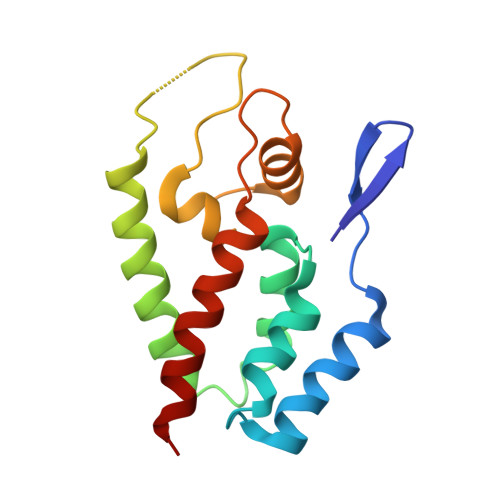Gain-of-Sensitivity Mutations in a Trim5-Resistant Primary Isolate of Pathogenic SIV Identify Two Independent Conserved Determinants of Trim5alpha Specificity.
McCarthy, K.R., Schmidt, A.G., Kirmaier, A., Wyand, A.L., Newman, R.M., Johnson, W.E.(2013) PLoS Pathog 9: e1003352-e1003352
- PubMed: 23675300
- DOI: https://doi.org/10.1371/journal.ppat.1003352
- Primary Citation of Related Structures:
4HTW - PubMed Abstract:
Retroviral capsid recognition by Trim5 blocks productive infection. Rhesus macaques harbor three functionally distinct Trim5 alleles: Trim5α(Q) , Trim5α(TFP) and Trim5(CypA) . Despite the high degree of amino acid identity between Trim5α(Q) and Trim5α(TFP) alleles, the Q/TFP polymorphism results in the differential restriction of some primate lentiviruses, suggesting these alleles differ in how they engage these capsids. Simian immunodeficiency virus of rhesus macaques (SIVmac) evolved to resist all three alleles. Thus, SIVmac provides a unique opportunity to study a virus in the context of the Trim5 repertoire that drove its evolution in vivo. We exploited the evolved rhesus Trim5α resistance of this capsid to identify gain-of-sensitivity mutations that distinguish targets between the Trim5α(Q) and Trim5α(TFP) alleles. While both alleles recognize the capsid surface, Trim5α(Q) and Trim5α(TFP) alleles differed in their ability to restrict a panel of capsid chimeras and single amino acid substitutions. When mapped onto the structure of the SIVmac239 capsid N-terminal domain, single amino acid substitutions affecting both alleles mapped to the β-hairpin. Given that none of the substitutions affected Trim5α(Q) alone, and the fact that the β-hairpin is conserved among retroviral capsids, we propose that the β-hairpin is a molecular pattern widely exploited by Trim5α proteins. Mutations specifically affecting rhesus Trim5α(TFP) (without affecting Trim5α(Q) ) surround a site of conservation unique to primate lentiviruses, overlapping the CPSF6 binding site. We believe targeting this site is an evolutionary innovation driven specifically by the emergence of primate lentiviruses in Africa during the last 12 million years. This modularity in targeting may be a general feature of Trim5 evolution, permitting different regions of the PRYSPRY domain to evolve independent interactions with capsid.
Organizational Affiliation:
Harvard Program in Virology, Harvard Medical School, Boston, Massachusetts, United States of America.














